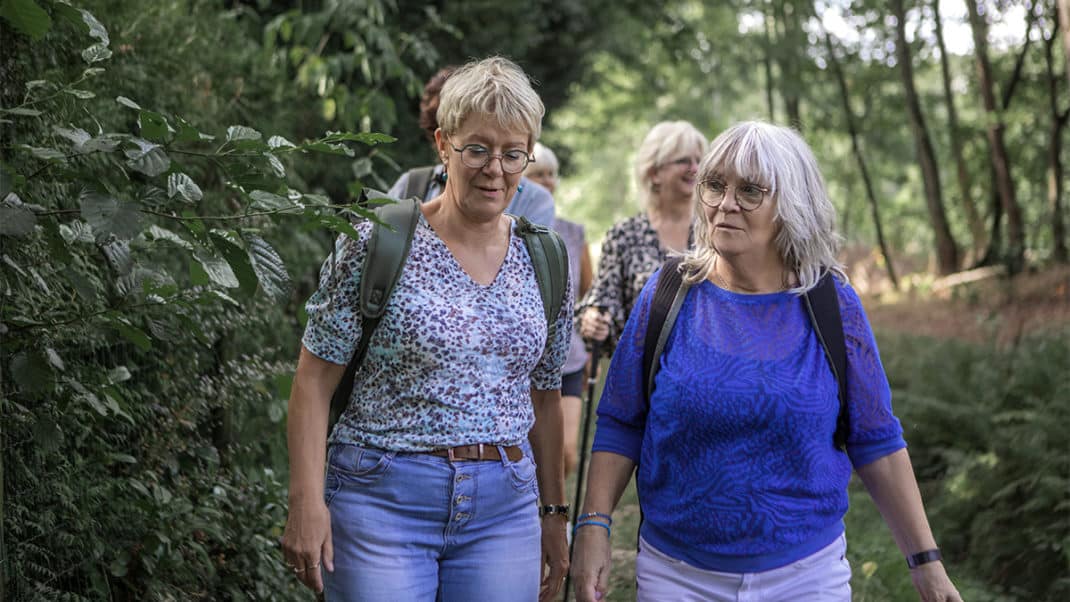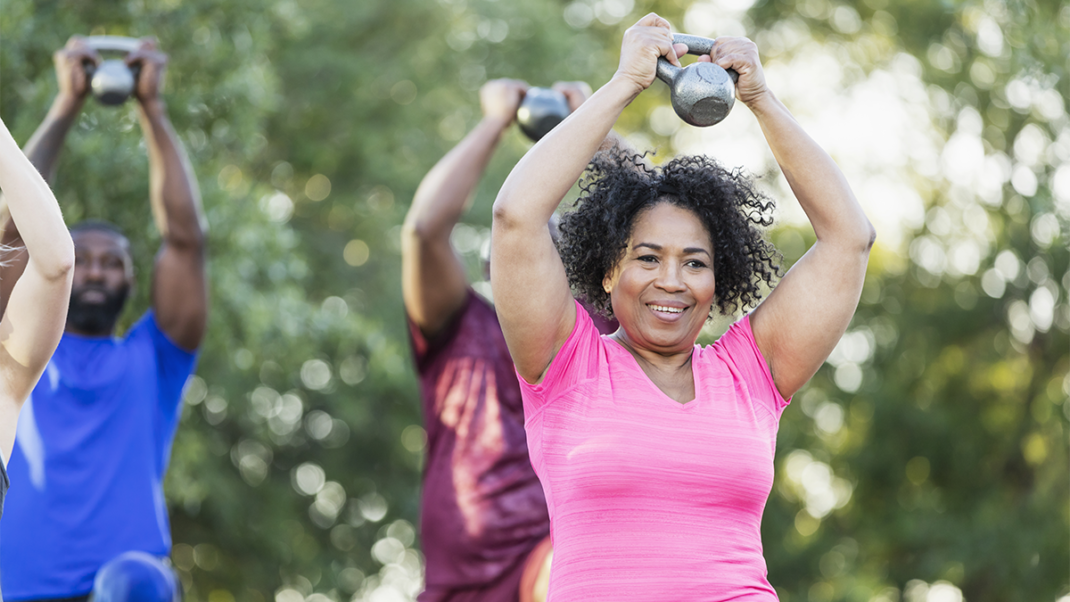Off-Center Ball Training
Use asymmetrical and unilateral movements to create new core challenges in your ball workouts.
Chaos is coming, so you’d better train for it.
This is something I tell almost all of my clients, and it applies to everyone. The need for random, unbalanced, asymmetrical movement will present itself sometime in our future. It could be in response to slipping on a wet floor, riding a subway train, carrying a wiggly child or playing a sport. Being ready for events like these is what core training means to our clients.
Effective core training enhances the ability of core muscles to control the position and motion of the trunk relative to the pelvis and legs. The core muscles don’t get more stable, but they do achieve greater contractile ability to create stability in the lumbopelvic region. With a clear understanding of the goals of core training, we can effectively use many pieces of fitness equipment, including stability balls. By exercising with these balls, we can potentially achieve greater core muscle activation. Given that the nervous system learns with relative rapidity (compared with the time it takes to develop strength), many stability ball exercises can be mastered in a short period of time.
The use of a stability ball does not automatically mean we are training appropriately for improved function. Functional training is not defined by the equipment we choose, but by how we use that equipment. For example, someone standing on a stability ball cannot possibly be training for function as, in this situation, the demands placed on the stabilizers are so excessive that the prime movers must shift roles and act as stabilizers, the opposite of their primary function.
How can we create appropriate, progressive challenges using a stability ball? Many common stability ball exercises have similar characteristics: symmetrical positions and bilateral movements by participants. However, consider just about all the movements we do as part of our day, from carrying things and riding the bus or subway to climbing stairs and playing sports. These movements are rarely symmetrical, and the majority of them are unilateral. Knowing this can help us create stability ball progressions that address daily activities.
By employing the essential principles of physics, we can develop a diverse array of exercise options; and by introducing asymmetrical and unilateral movements, we can create new challenges. Once we begin manipulating center of gravity, torque and angular momentum, a whole new world unfolds and the possible modifications for stability ball exercises seem endless.
The Physics of Off-Center Stability Ball Exercises
The center of gravity is the imaginary point at which all of an object’s mass is said to be concentrated when acted on by gravity. In humans this point lies approximately at the second sacral vertebra, slightly in front of the sacrum when standing in anatomical neutral. Torque is a force that produces rotation about an axis, as well as a measure of a force’s ability to twist an object. Angular momentum describes the rotation of a system about an axis, or its tendency to keep rotating. It is constant if there is no change in torque.
You most likely already understand how these concepts work. For example, consider a figure skater who spins faster when the arms are drawn in. (This represents an increase in angular momentum from using shorter levers.) Another example can be found in the lateral dumbbell raise. It takes a greater amount of force to move the weight when your arms are straighter than it does when your arms are bent.
A Core Consideration
If using stability balls helps us “work our core,” it is reasonable to consider exactly what that means. Core endurance is more desirable than, and should be considered a prerequisite to, core strength and power (Comana 2007). For example, consider the multifidus muscles, which lie deep in the back and provide segmental stability between adjacent vertebrae. The multifidi are primarily type I fibers and are thus best trained with lower loads and higher repetitions (Comana 2007). The low back is the third most common area for sports injuries (behind the ankle and the knee), and trunk muscle endurance correlates with a lower incidence of low-back pain and injury (Gamble 2007).
The main features of off-center ball exercises are asymmetry and rotational motion, and these qualities align perfectly with human movement. The lower parts of the rectus abdominis and external obliques play a significant role in preventing motion and providing stability for the lumbopelvic region (Sahrmann 2001). The core muscles function as antirotators (i.e., they prevent rotation). In the exercises shown in the sidebar, note how the core muscles work either to maintain a symmetrical position while the body is off-center or to control rotation and/or the movement of an extremity in an asymmetrical position. Life and sport result in extreme loading of the spinal musculature but also in varying angles, positions and speeds of movement (Faries & Greenwood 2007).
Using Off-Center Exercises
Off-center exercises are appropriate for individuals who have already mastered many of the common stability ball exercises and have exhibited an ability to perform well in a symmetrical body position. Given the highly coordinated, asymmetrical nature of these exercises, they are best implemented before participants become fatigued.
A great benefit of these exercises is that, given the large degree of neurological stimulus and muscle activation achieved in these movements, a high volume of sets is unnecessary. This characteristic makes off-center ball
exercises a very economical choice for creating time-efficient, results-driven workout programs. When choosing
exercises, you should ask yourself two questions:
- Does this exercise make sense for the client’s goals?
- Can the client maintain stability of the lumbar spine to allow for mobility elsewhere?
Stability of the trunk allows effective movement farther out in the extremities. The human body is like a whip with one handle (the trunk) and four tails (the extremities). Stability at the “handle” during movement transfers power to the “tails.”
If you decide to introduce off-center work to your clients, you have options for creating your own variations of the “handle” or “tails.” You can either move the center of gravity away from the midline of the ball or move one or more extremities to change the effective location of the center of gravity away from its usual position. Use either of these two simple methods to create your own off-center exercises out of some movements you already use. Simply modify them using one or both of the methods, have fun and experiment.
To help you get started, here are nine different off-center ball exercises.
1. Lateral Arm Swing Crunch. From supine crunch position with torso on ball, start with both arms pointing right, left arm across chest (Figure 1a). As torso rises in crunch, sweep arms toward left so they are overhead at top of crunch (Figure 1b). When lowering torso, sweep arms fully to the left so they both point left in bottom position (Figure 1c). Perform 12–20 repetitions.
2. Prone Plank Cycling. From prone plank position with shins on ball and either hands or forearms on floor, shift body to one side so left leg is clear of ball and tucked in toward chest while right leg remains extended and on ball (Figure 2a). Perform exercise by “cycling” free left leg through flexion and extension, moving right (ball) leg in opposition to left leg and maintaining contact with ball (Figure 2b). Perform 8–10 repetitions on right leg, and then repeat with left leg on ball.
3. Torque Squat. Stand perpendicular to wall with right side toward it,feet wider than hip distance, arms fully extended and palms together (handsaligned with sternum), retaining ball against wall with back of right hand.Hands are positioned slightly higher than midline of ball (Figure 3a). Applyjust enough pressure to hold ball in place and squat while allowing ball toroll down wall (Figure 3b). Return to start position. Perform 10 repetitionsper side.
4. Robot Squat. Stand with ball against wall and lumbar spine againstball, feet hip width apart. Move hips down into bottom of squat (Figure 4a).As you rise from bottom of squat, pivot leftward onto left heel and righttoes. You¹ll be facing left at top of squat (Figure 4b). Rotate back tocenter as you lower into next squat. As you rise, pivot rightward onto rightheel and left toes (Figure 4c). Perform 10&ndash­12 repetitions per side.
5. Shifting Off-Center Push-Up. From prone plank push-up position with legs on ball, walk hands slightly to the right. Keeping both legs on ball and shoulders aligned with hands, perform push-up (Figure 5a). At top, walk hands leftward, passing middle position (with lateral hand shift between repetitions) (Figure 5b) so hands shift to the left. Perform next push-up (Figure 5c). Perform 4–6 push-ups per side.
6. Stutter-Step Hamstring Curl. Lying supine on floor with ankles on top of ball, raise hips slightly off floor (Figure 6a). Lift right foot off ball and bend left knee slightly to pull ball toward hips (Figure 6b). Return right foot to ball and lift off left foot, bending right knee slightly to pull ball toward hips (Figure 6c). Repeat in this fashion until ball is all the way to your hips. Think of “walking” ball to hips using your heels, moving ball only an inch or two for each step. Perform 6–8 times, moving ball all the way in and all the way back out again.
7. Lateral Rolling Plank. Begin in prone plank position on toes, with forearms and elbows on top of ball, arms folded (i.e., with shoulders internally rotated) (Figures 7a and 7b). Rotate upper body rightward, going all the way around until back of left upper arm is on top of ball (Figures 7c and 7d). Rotate back to start position by pushing left arm into ball and keeping body rigid. Rotate left and repeat on right arm. There are two options for this exercise—shoulders rotated internally or externally. Perform 8–10 repetitions per side.
8. Off-Center Bridge. In supine position with head and neck on ball, place feet flat on floor directly under bent knees (Figure 8a). Shift body weight slightly to one side, then lower and raise hips straight down toward floor and up toward ceiling (Figure 8b). Perform 8–10 repetitions on each side.
9. Thread the Needle. From prone plank position with knees or shins on top of ball and hands on floor (Figure 9a), lift left leg off ball and rotate left hip up, allowing left leg to rotate behind you with left foot moving toward floor (Figure 9b). Stop at end range, and then swing left leg back around to front of body, passing through start position. From there, tuck left knee into chest, keeping right leg on ball, and extend (thread) left leg through space between right arm and ball, hovering just above floor (Figure 9c). Perform 4–6 repetitions with left leg, then change sides.
References
Faries, M.D., & Greenwood, M. 2007. Core training: Stabilizing the confusion. Strength and Conditioning Journal, 29 (2), 10–25.
Gamble, P. 2007. An integrated approach to training core stability. Strength and Conditioning Journal, 29 (1), 58–68.
Sahrmann, S. 2001. Diagnosis and Treatment of Movement Impairment Syndromes. St. Louis, MO: Mosby.
Jonathan Ross
Jonathan Ross is the owner of Aion Fitness in Bowie, Maryland. He is a finalist for the 2009 IDEA Personal Trainer of the Year award and the recipient of the 2008 Exercise TV's Top Trainer and the 2006 ACE Personal Trainer of the Year awards.
Certifications: ACE, NSCA














